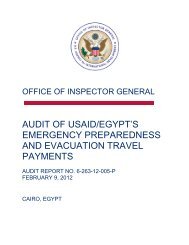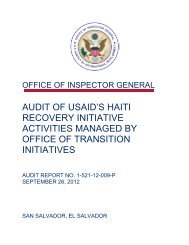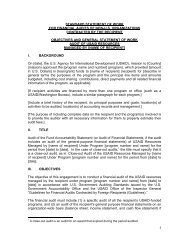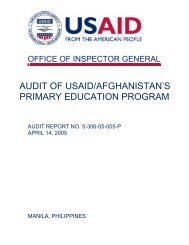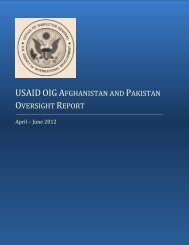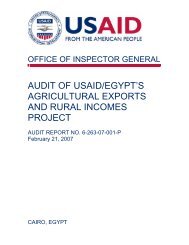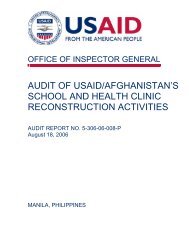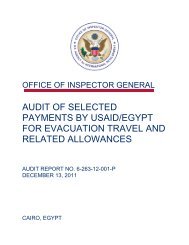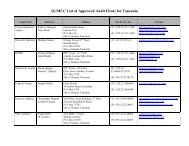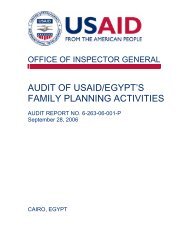Audit of USAID/Haiti's Public Law 480 Title II Programs
Audit of USAID/Haiti's Public Law 480 Title II Programs
Audit of USAID/Haiti's Public Law 480 Title II Programs
Create successful ePaper yourself
Turn your PDF publications into a flip-book with our unique Google optimized e-Paper software.
SCOPE AND METHODOLOGYScopeAppendix IRIG/San Salvador conducted this performance audit in accordance with generally acceptedgovernment auditing standards. Those standards require that we plan and perform the audit toobtain sufficient, appropriate evidence to provide a reasonable basis for our audit findings andconclusions in accordance with our audit objectives. We believe that the evidence obtainedprovides that reasonable basis.The objective <strong>of</strong> the audit was to determine whether <strong>USAID</strong>’s P.L. <strong>480</strong> <strong>Title</strong> <strong>II</strong> program in Haiti isreducing food insecurity and increasing the resiliency <strong>of</strong> vulnerable and extremely vulnerablerural households. In addition, the Inspector General Act <strong>of</strong> 1978, as amended, requires auditorsto promote economy, efficiency, and effectiveness in the administration <strong>of</strong> <strong>USAID</strong> programs andto prevent and detect fraud and abuse in such programs and operations.In planning and performing the audit, we assessed the mission’s controls related to its P.L. <strong>480</strong><strong>Title</strong> <strong>II</strong> program. The management controls identified included review <strong>of</strong> <strong>USAID</strong>/Haiti’s August2011 operational plan, the mission’s FY 2010 annual self-assessment <strong>of</strong> management controls(which the mission is required to perform to comply with the Federal Managers’ FinancialIntegrity Act <strong>of</strong> 1982), the mission data quality assessments, site visit reports by the missionstaff, review <strong>of</strong> AOTR 15 files, and portfolio reviews.RIG/San Salvador conducted the audit in various locations in central, south, and southeastHaiti. Field visits were made November 7 to November 18, 2011, and December 5 toDecember 16, 2011.<strong>USAID</strong>/Haiti’s P.L. <strong>480</strong> <strong>Title</strong> <strong>II</strong> MYAP is funded under three main conduits: internal transport,shipping and handling (ITSH), which funds in-country costs directly associated with moving foodaid to storage and distribution sites and for storing and distributing the food; PL <strong>480</strong> <strong>Title</strong> <strong>II</strong>Section 202(e) which funds program materials, tools and equipment, administrative costs,management, and personnel costs; and monetization, 16 in which funds derived from the sale <strong>of</strong>commodities are used to cover costs not permitted for use under ITSH or P.L. <strong>480</strong> <strong>Title</strong> <strong>II</strong>,Section 202(e). The bulk <strong>of</strong> the program costs, however, are food commodities and shippingcosts to the host country, which are paid directly by <strong>USAID</strong>. Commodities are granted to thecooperating sponsors. Monetization proceeds are derived from the sale <strong>of</strong> a portion <strong>of</strong> thesecommodities. Our audit focused on MYAP activities performed under three cooperativeagreements with CRS, World Vision, and ACDI/VOCA.15 On January 1, 2012, <strong>USAID</strong> changed the term “AOTR” to “AOR” (agreement <strong>of</strong>ficer’s representative)to align with changes in the Federal Acquisition Regulation. Because audit fieldwork occurred beforethe change, this report uses AOTR.16Monetization in Haiti was halted in FY 2010 for the remainder <strong>of</strong> the MYAP because it was notsuitable.19



